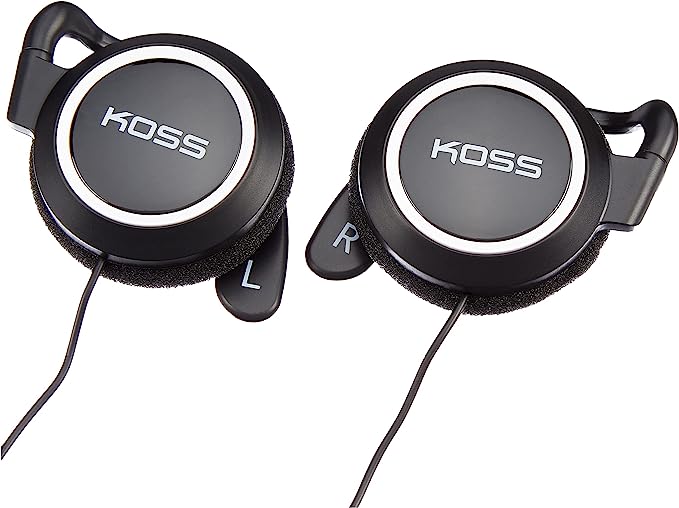Ever found yourself in a silent battle with your headphones? Perhaps you’re a runner, torn between the energizing pulse of your playlist and the crucial need to hear an approaching cyclist. Or maybe you wear glasses, and the relentless pressure of an over-ear set transforms your listening pleasure into a literal headache. It could even be the subtle, isolating feeling of being too cocooned from your home environment while working, missing the doorbell or a family member’s call. These everyday discomforts and dilemmas highlight a profound truth: our relationship with personal audio is deeply intertwined with comfort, awareness, and often, the unsung science of thoughtful design.
Today, I want to guide you through an exploration of these principles, using a rather unassuming subject as our lens: the Koss KSC21 SportClip Clip-On Headphones. You might see them as a simple, budget-friendly option, perhaps a throwback to an earlier era of personal audio. Yet, as a psychoacoustician and someone fascinated by ergonomic hardware, I find that designs like the KSC21 often harbor an elegant application of scientific understanding that allows them to endure. So, let’s delve into what these headphones can teach us about the intricate dance between sound, the human body, and the world around us.

The Gentle Embrace – Unpacking the Ergonomic Enigma of the Clip-On
The first promise any good personal audio device must keep is that of comfort. If it’s a chore to wear, the quality of the sound it produces becomes almost irrelevant. The KSC21, with its clip-on, on-ear design, addresses this fundamental need through several clever, if understated, ergonomic considerations.
The Vanishing Act of 1.6 Ounces
Consider the listed weight of the KSC21: a mere 1.6 ounces, or roughly 45 grams. This isn’t just a statistic; it’s a cornerstone of its ergonomic philosophy. In the world of physics, less mass means less inertia, especially during movement. When you’re jogging or simply turning your head, a lighter headphone exerts significantly less force on your ears and skull. Over extended periods, this translates into a dramatic reduction in strain and fatigue. It’s the difference between feeling the presence of a device and it almost “vanishing” into the background of your sensory experience – a quality many users, like one on Amazon who described them as “light weight,” intuitively appreciate.

Anatomy of a Clip: A Dialogue with Your Ear’s Landscape
The “SportClip” design itself is a fascinating study in biomechanics. Unlike earbuds that can exert pressure within the sensitive ear canal, or circumaural (over-ear) headphones that can cause heat buildup and pressure points around the entire ear, the KSC21’s clips aim for a more targeted, distributed support. They gently grip the auricle (the external part of the ear), while the main body rests on the ear. This approach, for many, sidesteps common discomforts.
Further enhancing this individualized fit are the pivoting ear plates. Your ears, like fingerprints, are unique. A rigid headphone design simply cannot accommodate this beautiful human variability. The KSC21’s earpieces, however, can rotate slightly. This seemingly small mechanical feature is crucial. It allows the headphone to better conform to the specific angles and contours of your ears, ensuring a more secure yet gentle contact. This adaptability not only improves comfort but can also subtly optimize the sound delivery by maintaining a more consistent distance and angle between the transducer (the part that makes sound) and your ear canal. As one user, Jason, noted in a review on the Amazon product page, these “pivoting ear plates” were a hidden gem, making them “extremely comfortable.”
A Cushion for Your Thoughts (and Ears)
The final touch in this ergonomic puzzle is the choice of soft foam ear cushions. From a material science perspective, open-cell foam is an excellent choice for this application. It’s compliant, meaning it readily deforms to match the shape of your ear, distributing pressure more evenly and reducing hot spots. It’s also breathable, which can be a significant advantage over the synthetic leathers or dense foams found on some sealed headphones, especially during exercise or in warmer climates. These cushions also play a subtle acoustic role, helping to create a loose seal that can gently enhance bass perception without creating an isolating pressure. For individuals who wear glasses, this entire ensemble – lightweight construction, ear-hugging clips, and forgiving foam – can be a game-changer, avoiding the painful pressure that larger headphones often exert on the arms of their spectacles. This sentiment was echoed by Lilli H.K. in her Amazon review, who found them a welcome alternative after struggling with other headphone styles that “squish your ears and head (especially if you wear glasses like I do).”
When Your Music Breathes – The Acoustic Alchemy of Open-Air Listening
Beyond physical comfort, the way headphones interact with the soundscape of your environment is a critical aspect of their design, profoundly influencing both your listening experience and your connection to the world. The Koss KSC21 is explicitly described as having an “open, hear-through sound,” a characteristic rooted in fundamental acoustic principles.
The World as Your Soundstage
Imagine sound waves like ripples in a pond. In a “closed-back” headphone, these ripples are largely contained within the earcup, bouncing off the housing and directing most of their energy towards your ear. This can create a very direct, intense, and isolated sound. “Open-back” headphones, or on-ear designs like the KSC21 that don’t form a tight seal, operate differently. They allow sound waves to escape outwards and, crucially, allow external sounds to filter in.
This “acoustic transparency” has several interesting effects. Firstly, many listeners find it creates a more natural, spacious soundstage. Instead of the music feeling like it’s being injected directly “in your head,” it can feel more like a performance happening around you, in the same acoustic space you inhabit. This can reduce the sense of listening fatigue some people experience with highly isolating headphones. Secondly, it allows your ears to “breathe” acoustically, preventing that sometimes disorienting pressure buildup.
The “Noise Cancellation” Conundrum: A Feature in Disguise?
It’s interesting to note that the product information for the KSC21 on the Amazon page lists “noise-cancellation” as a special feature. This can be a point of confusion, as the “open, hear-through sound” is a more dominant and, I would argue, intended characteristic of its physical design. True active noise cancellation involves sophisticated electronics that detect and actively counteract external noise. An open, on-ear design like the KSC21 inherently does the opposite: it allows environmental sound to be part of your auditory experience.
Why is this “hear-through” nature often a deliberate and desirable feature? Because in many situations, total sonic isolation is neither safe nor practical. This is where the psychoacoustics of listening come into play.
Psychoacoustics on the Pavement (and in the Office)
Our brains are wired to process ambient sounds constantly, assessing them for threats, opportunities, or simple social cues. When you’re jogging through city streets, hearing an approaching car, a bicycle bell, or another pedestrian is vital for safety. Lilli H.K.’s review highlighted this perfectly, stating these headphones “allowed just enough ambient sounds that I could still listen for my kids if they called my name, cars coming, and my phone ring.” This ability to maintain situational awareness while still enjoying audio content is a significant benefit.
Even in less overtly hazardous environments, like an office or at home, this permeability can be advantageous. You can remain aware of a colleague trying to get your attention, the aforementioned doorbell, or the subtle sounds that keep you connected to your immediate surroundings. For some, this reduces the feeling of being “closed off” and can even make extended listening periods feel less mentally taxing. As Wilson S. noted in his review, “It also doesn’t isolate outside noise much. I want to be able to hear my surrounding in my case, so not a problem for me.”
What’s That Sound? Deciphering 20Hz-20kHz & 26 Ohms
Now, let’s briefly touch upon the numbers. The KSC21 headphones are specified with a frequency response of 20Hz to 20,000Hz (20kHz). This range, in theory, covers the entire spectrum of human hearing – from the deep rumble of a bass drum (around 20-50Hz) through the richness of human voices and instruments in the mid-ranges, all the way up to the delicate shimmer of cymbals or the highest harmonics that give instruments their “air” and detail (approaching 20kHz). While a wide frequency response doesn’t solely dictate sound quality (driver quality, enclosure design, and many other factors play a role), it indicates the potential to reproduce the full tapestry of most musical recordings.
The impedance is listed at 26 Ohms. In simple terms, impedance is a measure of electrical resistance. A lower impedance, like 26 Ohms, generally means the headphones are easier for an audio source to “drive” or power effectively. This is excellent news for use with portable devices like smartphones, tablets, and laptops, which typically have modest power output from their headphone jacks. You won’t need a dedicated headphone amplifier to achieve satisfying volume levels and dynamic range. Users have indeed noted a pleasing audio output for the price, with one reviewer identified as “K” mentioning they “sound better than their audio technica counterpart. More low end with a fuller tone, and treble is not too harsh,” while Wilson S. appreciated the bass performance for a clip-on at this price.
A Legacy of Listening – Koss, Simplicity, and Enduring Value
It’s worth taking a moment to place the KSC21 within a broader context. The Koss Corporation, founded in Milwaukee in 1953, holds a rather special place in audio history. In 1958, John C. Koss and Martin Lange Jr. introduced the Koss SP/3 – the world’s first commercial stereophones. This invention fundamentally changed how people experienced recorded music, ushering in an era of personal, immersive listening.
While the KSC21 is a much simpler and more contemporary offering, that pioneering spirit—the desire to make audio personal and accessible—can be seen as an undercurrent. In an age where audio technology often hurtles towards increasing complexity and feature sets, there’s an eloquent honesty to a product like the KSC21. It doesn’t try to be all things to all people. Instead, it focuses on a core set of user needs: comfortable and stable wear for active use, an awareness of one’s surroundings, and a pleasant audio experience, all without breaking the bank.
This isn’t the headphone you’d choose for critical studio monitoring in a noisy environment, nor would it be the first pick for a completely immersive, noise-obliterating commute on a loud train. But for that morning jog, for listening to a podcast while keeping an ear out for the kids, for a comfortable audio companion that doesn’t demand precious battery life or complex pairing procedures, its design choices make a compelling case. It embodies a “just enough” philosophy: providing the necessary features, executed thoughtfully, to deliver on its specific promises.
Concluding Thoughts: Beyond the Wires – Listening Smarter, Living Better
The Koss KSC21 SportClip headphones, in their unassuming way, offer us a valuable lesson. They remind us that effective design isn’t always about the latest, most complex technology, but about a deep understanding of human needs and the clever application of fundamental ergonomic and acoustic principles. From the almost imperceptible lightness of their build to the ear-friendly embrace of their clips and the liberating transparency of their open sound, every element seems geared towards a harmonious coexistence with the listener and their environment.
As you navigate the ever-expanding universe of personal audio technology, I encourage you to look beyond the marketing buzz and the spec sheets. Consider the science of how a device will interact with your body, how it will shape your perception of sound, and how it will integrate into the rhythm of your life. Sometimes, the most profound solutions are found in the simplest of forms, waiting to be appreciated not just for what they do, but for the quiet intelligence with which they do it. The KSC21, for many, is a testament to that enduring wisdom.




